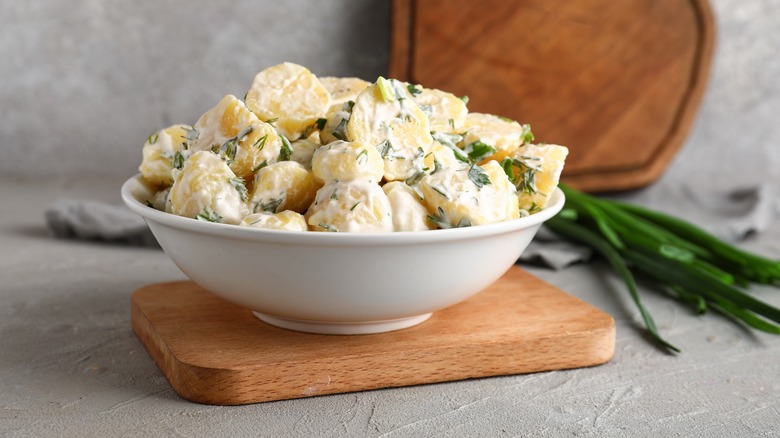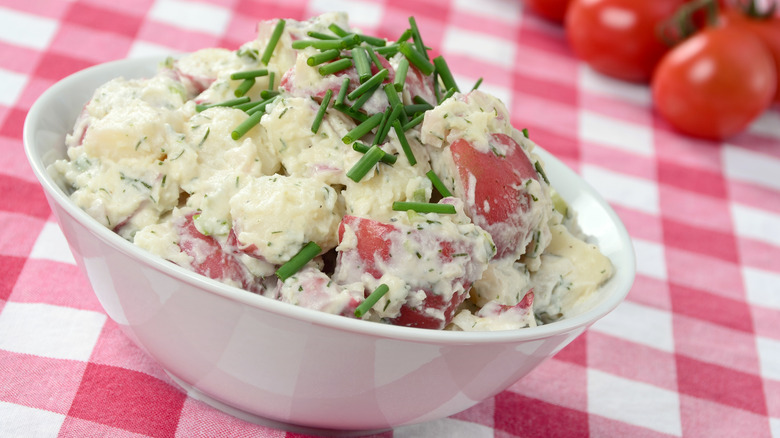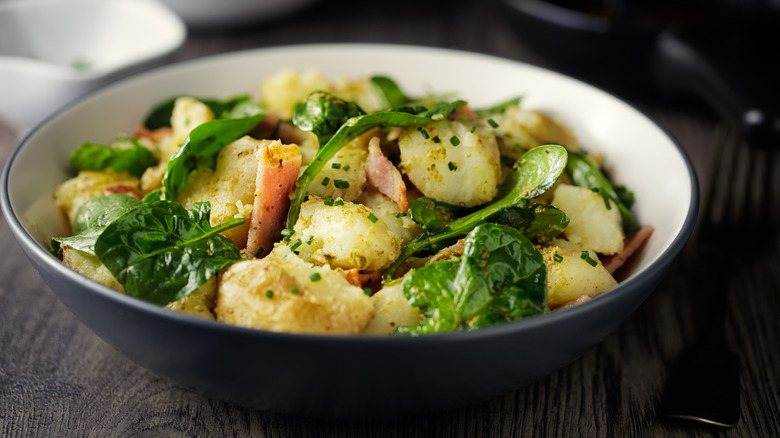How To Boil Potatoes For Tender, Fluffy Potato Salad
There are few things as delectable as tender, fluffy potato salad on a sunny day. When done right, this side dish offers a rich, creamy texture that feels refreshing at any hour. However, despite potatoes being some of the easiest vegetables to cook, one wrong move during the cooking process can easily turn this classic recipe into an inedible mess. The crucial step that will make or break your salad lies in how you boil your potatoes, starting from the moment you add them to water.
When you add raw potatoes straight into boiling liquid, their exterior will quickly tenderize, leaving you with unevenly cooked cubes that may have an underdone interior or a mushy surface. To avoid this issue, start making potato salad with cold water, as the gradual rise in temperature allows the insides of the spuds more time to cook.
Once you start boiling your potatoes in cold water, routinely poke a piece or two with a fork to check their doneness. While the exact timing depends on the variety chosen, perfectly cooked potatoes can be easily pierced with a utensil without crumbling. Be conservative with the cooking time, as you can't undo an overcooked potato.
Pick waxier spuds for the best texture
Unless you're making silky mashed potatoes, most people agree that the best kinds of potatoes for boiling are waxy varieties such as reds and fingerlings. These spuds hold their shape better during cooking due to their minimal starch content and hydration level, making their cell walls tougher to break down. This quality makes them perfect for potato salads, as you'll want your potato cubes to maintain their shape when mixed with other ingredients. Starchier potatoes like russets do not have the same level of cellular strength due to their dryness and high starch content, leading to mushier results more quickly.
If you don't have waxy potatoes on hand, don't worry. As their name suggests, all-purpose varieties like Yukon Golds work well for making excellent potato salad. Just keep a more careful eye on these spuds during boiling and mixing, as they are slightly more fragile than their tough, waxy counterparts.
Don't forget to season your water during boiling
Seasoning can make or break any dish, and potato salads are no exception. While this recipe often involves coating spuds in a savory mayonnaise dressing or vinaigrette, you shouldn't rely on your sauce to do all the work in the flavor department. When properly seasoned, potatoes have an earthy undertone that few other vegetables can replicate. One of the easiest ways to bring out this flavor is by adding a pinch of salt to the water, allowing the potatoes to absorb it during boiling and infuse their interiors with flavor.
After boiling your potatoes in salted water, let them rest for a few minutes before adding the rest of your ingredients. Incorporating a dressing too soon can lead to the spuds absorbing it or, in the case of mayonnaise-based sauces, breaking the emulsion and releasing unwanted oils. Once cooled, potato salads are highly customizable with ingredients such as relish and deviled eggs, so feel free to experiment with flavors that catch your interest.



